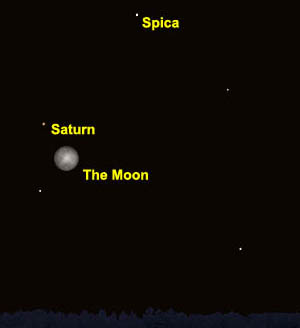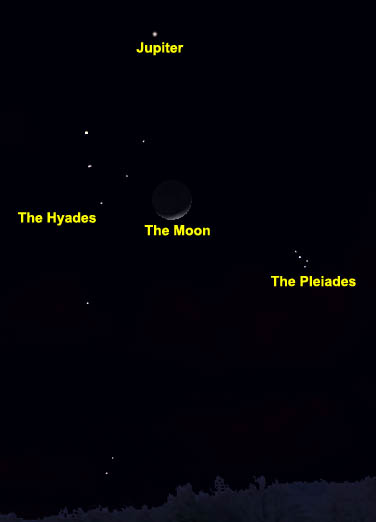
The beautiful, ringed planet Saturn shines at its brightest for 2013 this month. That’s because on April 28 the planet will reach “opposition,” meaning at sunset that evening Saturn will appear just over the eastern horizon, on the exact opposite side of the sky as the setting Sun. But you can get a good look at Saturn and its rings throughout the month, and for the next several months, through even small telescopes. Saturn will reside in the Name A Star Live constellation Libra throughout April.
Saturn will be about 9 Astronomical Units (AU) from Earth in April. An AU is the average distance of the Earth from the Sun, or about 93 million miles. So in April, Saturn will be about 9 times farther away from Earth than the Earth is from the Sun.
If you view Saturn through a telescope, you should be able to make out some of Saturn’s large moons, especially the largest, and brightest, moon: Titan. It orbits the planets once every 16 days. NASA’s Cassini spacecraft “has revealed that Titan’s surface is shaped by rivers and lakes of liquid ethane and methane (the main component of natural gas), which forms clouds and occasionally rains from the sky as water does on Earth.”
Take A Break from Your Taxes and Look at Jupiter!

The Moon also passes by our solar system’s giant planet, Jupiter, this month. Jupiter is in the Name A Star Live constellation Taurus in April. The crescent Moon will lie near Jupiter the night of April 14. So if preparing your income tax returns is driving you crazy that night, take a break, step outside and look for the crescent Moon. Jupiter will be the brightest point of light near the Moon. If you have a telescope, look at Jupiter and see if you can view its four largest moons — the “Galilean satellites.” These four moons move very quickly: They noticeably change their position over the course of just a few hours. But those of you in the northern hemisphere of Earth (e.g., North America, Europe) will likely see all four moons that night in the following order (listed from nearest Jupiter and going out): Io, Europa, Ganymede and Callisto.
And consider viewing the Moon the preceding evening when it will lie between the “Hyades” and the “Pleiades” in the Name A Star Live constellation Taurus.
Finding your star in the night sky
Stars are located within constellations, which are just areas of the night sky. Scorpius, Aries and Taurus are examples of constellations. Your Name A Star Live Star Certificate displays the name of your constellation. You can use our online World Constellation Guide to determine if you can see your constellation during the evening hours (between sunset and midnight). Of course, you’ll need a telescope to see your star. But you can see your constellation without the use of a telescope. You can also find your constellation by using our Virtual Planetarium™ astronomy software. A planisphere is another useful device.